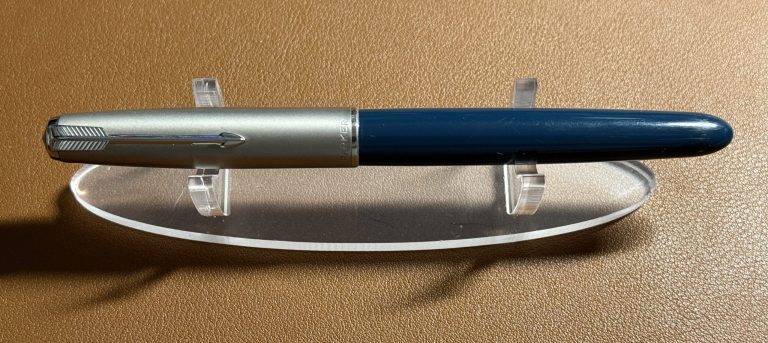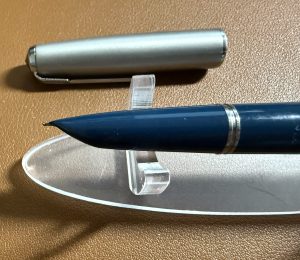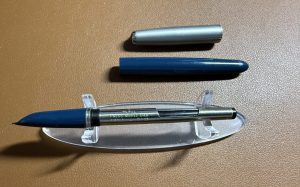
The Parker 51 is a beautiful and unique pen designed in 1939 and first released in 1941. It was designed as a tribute to Parker Pens’ 51st year of company operations. In 1945, the Parker 51 was used by Dwight D. Eisenhower to sign the German surrender document at the end of World War II. The Parker 51 went on to become one of the most iconic pens made by Parker.
The design of the Parker 51 was unique and ground-breaking when it was first introduced in 1941. One of the most recognized design elements of this pen is the hooded nib.

This design element refers to the way the nib is partially concealed behind the end of the pen body. This gave the pen a smooth and connected finish at the end. Instead of the normal design of a nib sticking out at the end, the Parker 51 hid all but the point of the nib, providing continuity to the overall pen design.
Though other pen manufacturers subsequently used the hooded nib design, the Parker 51 was the first. Shortly after its release, other manufacturers, such as Stylomine, began to produce similar hooded nibs. Beyond just fashion, the hooded nib was designed to keep the nib wet, allowing for good ink flow while writing.
Another unique design element was the brushed metal pen cap. The cap utilized a brushed matte finish, accented with polished chrome at the bottom and top of the clip, as well as a polished clip. This design is attributed to Parker’s aim to create an aerodynamic aircraft-inspired design. Ultimately, the brilliant design won an Academy Award.

I purchased my Parker 51 on eBay for about $100. One thing to note when buying a vintage pen is whether the pen has been restored. A non-restored pen is more authentic, but may not have a working ink sac. I don’t know how to restore pens, so I always buy pens that have already been restored with working nibs, feeds, and ink sacs.
I find several satisfying elements to writing with a vintage and restored pen. The first is history. I can’t help but imagine all the people who have used this pen throughout its history. I imagine someone in the 1940s using this very same pen. I contrast this to the joy I have in writing with this same pen now. I can imagine my father or grandfather writing with this pen. Now, almost eighty years later, I am writing with this pen.
The other element I find satisfying with this vintage pen is its ability to write now as beautifully as it did eighty years ago. This element is only relevant to well-restored vintage pens. As such, this pen writes as well as any new pen.
Down to the detail. The model that I own has an aerometric filling mechanism.
Parker 51s were made with two main filling mechanisms, the vacumatic and aerometric ink fillers. The aerometric fillers employ an ink sac with a metal clip around each side of the ink sac.
To refill, the top of the pen is unscrewed, revealing the metal clip-covered ink sac. The pen is then dipped into an ink well or ink bottle, where the clip is squeezed.

Upon squeezing the inner clip, the ink sac is compressed. When released, the ink sac uses the vacuum pressure to draw ink through the pen tip into the ink sac reservoir.
As shown in the picture, my Parker 51 is a beautiful dark teal. The color is almost a dark green with a blue tint. If you’ve read my other Cross pen review, you know how much I love teal.
This Parker 51 weighs 20.4 grams, without any ink. The pen balances well in the center of the pen.Capped, the weight is well-balanced with a slight increase at the capped end.
In terms of writing, the Parker 51 writes beautifully. The lines are smooth and consistent. The sleek and hidden nib does seem to stay wet longer, maintaining consistent ink flow. However, I didn’t buy this pen because of how well it writes. Rather, I bought this pen for its beautiful design and history.
The Parker 51 is an iconic pen that deserves its place in any collection. They are certainly not cheap, but they are worth every penny.